Travis Kalanick was not ethical enough to steer Uber
VerifiedAdded on 2023/06/15
|11
|2991
|317
AI Summary
This report discusses the unethical practices of Travis Kalanick, ex CEO of Uber, and analyses Uber's operations from an ethical standpoint. It includes a discussion of ethical theories and the semiotic square. The report concludes that Kalanick was not ethical enough to steer Uber.
Contribute Materials
Your contribution can guide someone’s learning journey. Share your
documents today.
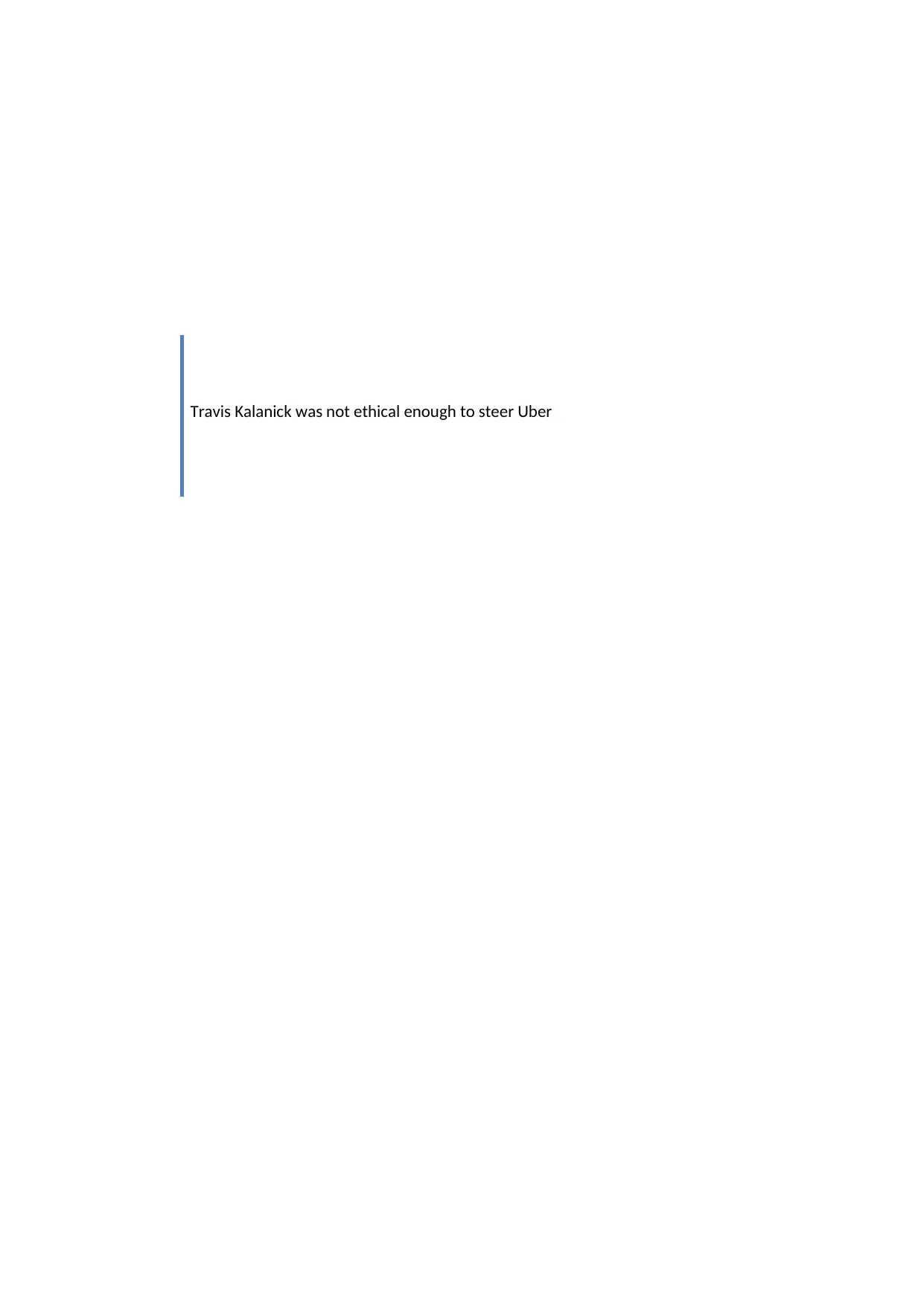
Travis Kalanick was not ethical enough to steer Uber
Secure Best Marks with AI Grader
Need help grading? Try our AI Grader for instant feedback on your assignments.
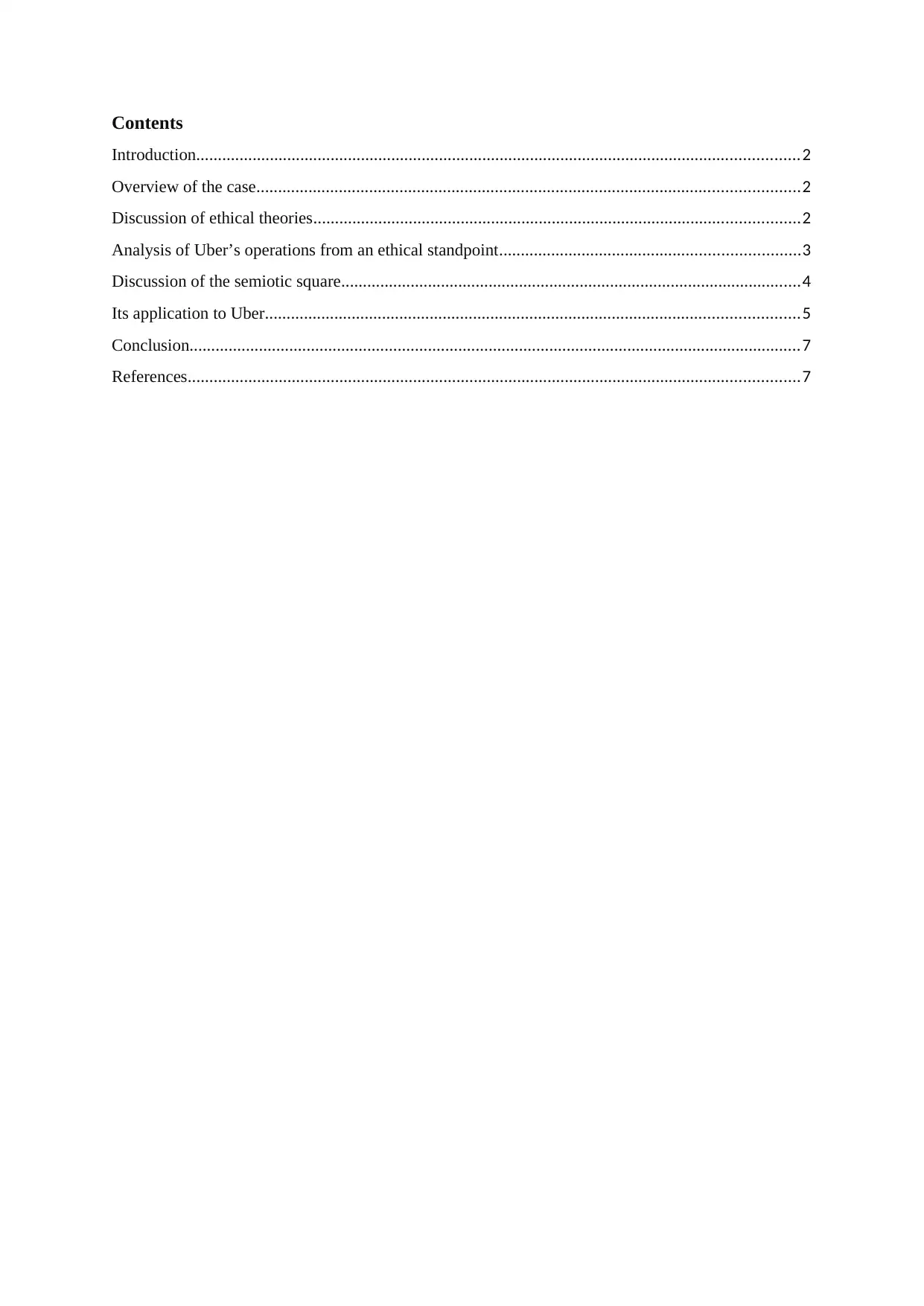
Contents
Introduction...........................................................................................................................................2
Overview of the case.............................................................................................................................2
Discussion of ethical theories................................................................................................................2
Analysis of Uber’s operations from an ethical standpoint.....................................................................3
Discussion of the semiotic square..........................................................................................................4
Its application to Uber...........................................................................................................................5
Conclusion.............................................................................................................................................7
References.............................................................................................................................................7
Introduction...........................................................................................................................................2
Overview of the case.............................................................................................................................2
Discussion of ethical theories................................................................................................................2
Analysis of Uber’s operations from an ethical standpoint.....................................................................3
Discussion of the semiotic square..........................................................................................................4
Its application to Uber...........................................................................................................................5
Conclusion.............................................................................................................................................7
References.............................................................................................................................................7
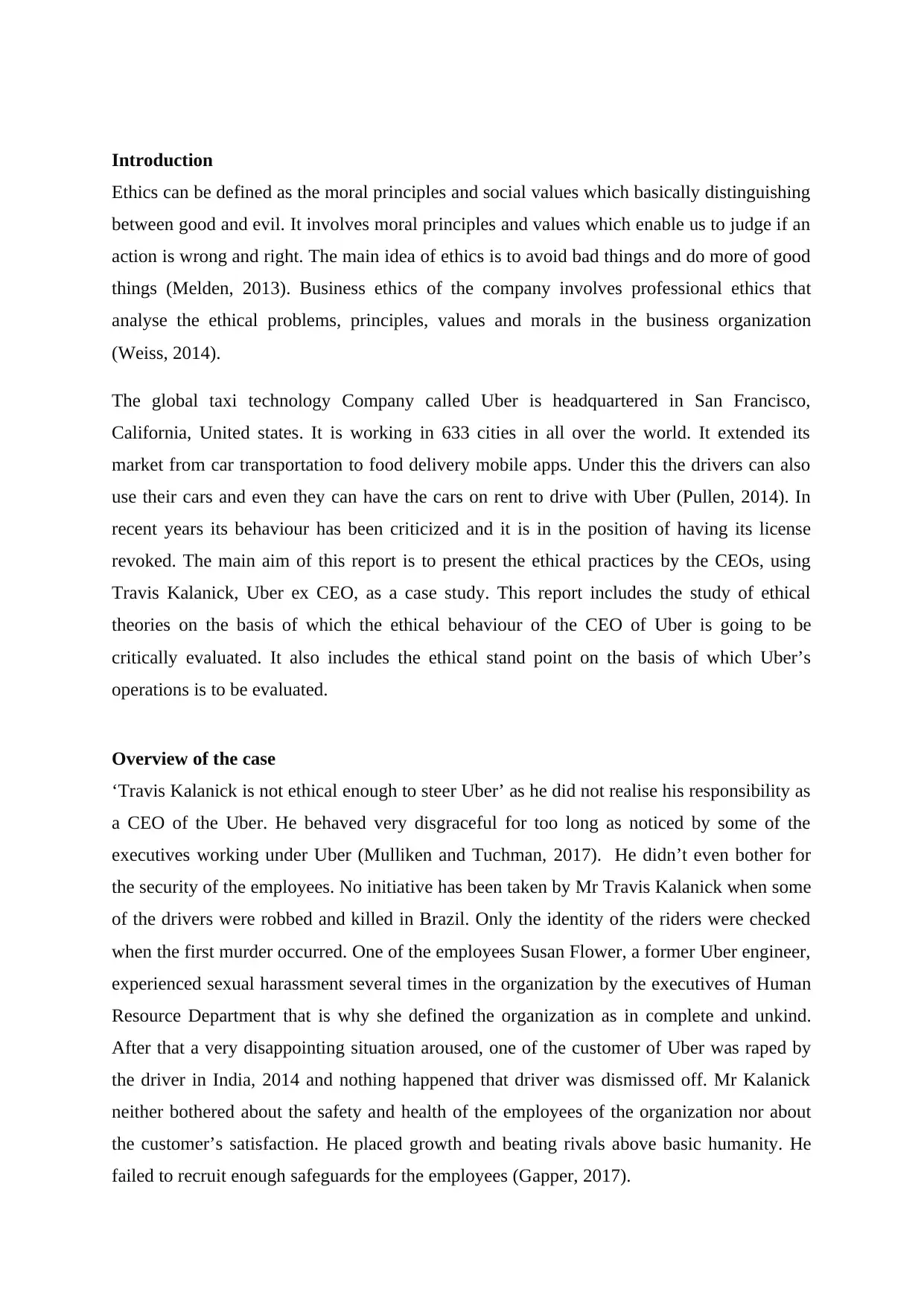
Introduction
Ethics can be defined as the moral principles and social values which basically distinguishing
between good and evil. It involves moral principles and values which enable us to judge if an
action is wrong and right. The main idea of ethics is to avoid bad things and do more of good
things (Melden, 2013). Business ethics of the company involves professional ethics that
analyse the ethical problems, principles, values and morals in the business organization
(Weiss, 2014).
The global taxi technology Company called Uber is headquartered in San Francisco,
California, United states. It is working in 633 cities in all over the world. It extended its
market from car transportation to food delivery mobile apps. Under this the drivers can also
use their cars and even they can have the cars on rent to drive with Uber (Pullen, 2014). In
recent years its behaviour has been criticized and it is in the position of having its license
revoked. The main aim of this report is to present the ethical practices by the CEOs, using
Travis Kalanick, Uber ex CEO, as a case study. This report includes the study of ethical
theories on the basis of which the ethical behaviour of the CEO of Uber is going to be
critically evaluated. It also includes the ethical stand point on the basis of which Uber’s
operations is to be evaluated.
Overview of the case
‘Travis Kalanick is not ethical enough to steer Uber’ as he did not realise his responsibility as
a CEO of the Uber. He behaved very disgraceful for too long as noticed by some of the
executives working under Uber (Mulliken and Tuchman, 2017). He didn’t even bother for
the security of the employees. No initiative has been taken by Mr Travis Kalanick when some
of the drivers were robbed and killed in Brazil. Only the identity of the riders were checked
when the first murder occurred. One of the employees Susan Flower, a former Uber engineer,
experienced sexual harassment several times in the organization by the executives of Human
Resource Department that is why she defined the organization as in complete and unkind.
After that a very disappointing situation aroused, one of the customer of Uber was raped by
the driver in India, 2014 and nothing happened that driver was dismissed off. Mr Kalanick
neither bothered about the safety and health of the employees of the organization nor about
the customer’s satisfaction. He placed growth and beating rivals above basic humanity. He
failed to recruit enough safeguards for the employees (Gapper, 2017).
Ethics can be defined as the moral principles and social values which basically distinguishing
between good and evil. It involves moral principles and values which enable us to judge if an
action is wrong and right. The main idea of ethics is to avoid bad things and do more of good
things (Melden, 2013). Business ethics of the company involves professional ethics that
analyse the ethical problems, principles, values and morals in the business organization
(Weiss, 2014).
The global taxi technology Company called Uber is headquartered in San Francisco,
California, United states. It is working in 633 cities in all over the world. It extended its
market from car transportation to food delivery mobile apps. Under this the drivers can also
use their cars and even they can have the cars on rent to drive with Uber (Pullen, 2014). In
recent years its behaviour has been criticized and it is in the position of having its license
revoked. The main aim of this report is to present the ethical practices by the CEOs, using
Travis Kalanick, Uber ex CEO, as a case study. This report includes the study of ethical
theories on the basis of which the ethical behaviour of the CEO of Uber is going to be
critically evaluated. It also includes the ethical stand point on the basis of which Uber’s
operations is to be evaluated.
Overview of the case
‘Travis Kalanick is not ethical enough to steer Uber’ as he did not realise his responsibility as
a CEO of the Uber. He behaved very disgraceful for too long as noticed by some of the
executives working under Uber (Mulliken and Tuchman, 2017). He didn’t even bother for
the security of the employees. No initiative has been taken by Mr Travis Kalanick when some
of the drivers were robbed and killed in Brazil. Only the identity of the riders were checked
when the first murder occurred. One of the employees Susan Flower, a former Uber engineer,
experienced sexual harassment several times in the organization by the executives of Human
Resource Department that is why she defined the organization as in complete and unkind.
After that a very disappointing situation aroused, one of the customer of Uber was raped by
the driver in India, 2014 and nothing happened that driver was dismissed off. Mr Kalanick
neither bothered about the safety and health of the employees of the organization nor about
the customer’s satisfaction. He placed growth and beating rivals above basic humanity. He
failed to recruit enough safeguards for the employees (Gapper, 2017).
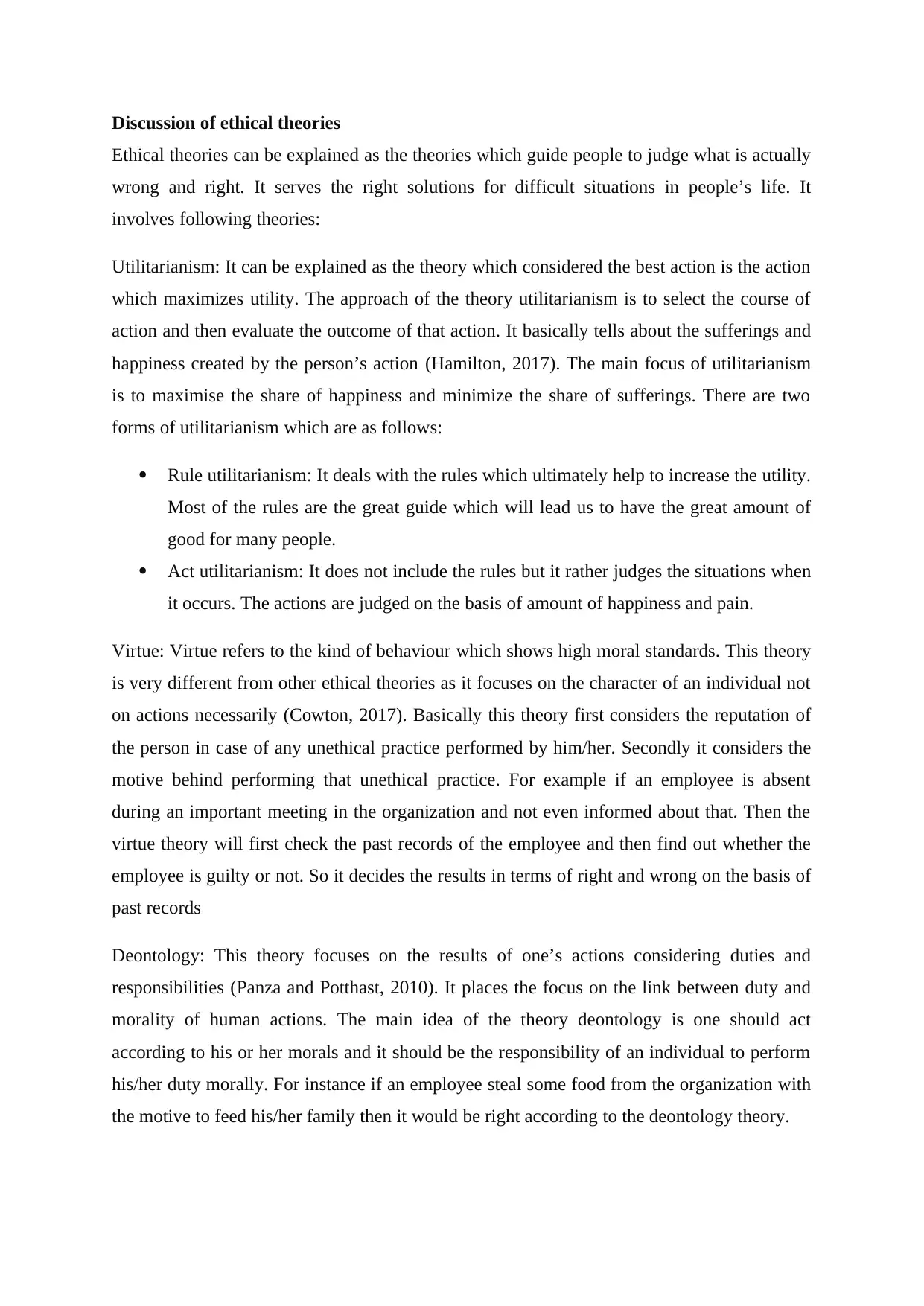
Discussion of ethical theories
Ethical theories can be explained as the theories which guide people to judge what is actually
wrong and right. It serves the right solutions for difficult situations in people’s life. It
involves following theories:
Utilitarianism: It can be explained as the theory which considered the best action is the action
which maximizes utility. The approach of the theory utilitarianism is to select the course of
action and then evaluate the outcome of that action. It basically tells about the sufferings and
happiness created by the person’s action (Hamilton, 2017). The main focus of utilitarianism
is to maximise the share of happiness and minimize the share of sufferings. There are two
forms of utilitarianism which are as follows:
Rule utilitarianism: It deals with the rules which ultimately help to increase the utility.
Most of the rules are the great guide which will lead us to have the great amount of
good for many people.
Act utilitarianism: It does not include the rules but it rather judges the situations when
it occurs. The actions are judged on the basis of amount of happiness and pain.
Virtue: Virtue refers to the kind of behaviour which shows high moral standards. This theory
is very different from other ethical theories as it focuses on the character of an individual not
on actions necessarily (Cowton, 2017). Basically this theory first considers the reputation of
the person in case of any unethical practice performed by him/her. Secondly it considers the
motive behind performing that unethical practice. For example if an employee is absent
during an important meeting in the organization and not even informed about that. Then the
virtue theory will first check the past records of the employee and then find out whether the
employee is guilty or not. So it decides the results in terms of right and wrong on the basis of
past records
Deontology: This theory focuses on the results of one’s actions considering duties and
responsibilities (Panza and Potthast, 2010). It places the focus on the link between duty and
morality of human actions. The main idea of the theory deontology is one should act
according to his or her morals and it should be the responsibility of an individual to perform
his/her duty morally. For instance if an employee steal some food from the organization with
the motive to feed his/her family then it would be right according to the deontology theory.
Ethical theories can be explained as the theories which guide people to judge what is actually
wrong and right. It serves the right solutions for difficult situations in people’s life. It
involves following theories:
Utilitarianism: It can be explained as the theory which considered the best action is the action
which maximizes utility. The approach of the theory utilitarianism is to select the course of
action and then evaluate the outcome of that action. It basically tells about the sufferings and
happiness created by the person’s action (Hamilton, 2017). The main focus of utilitarianism
is to maximise the share of happiness and minimize the share of sufferings. There are two
forms of utilitarianism which are as follows:
Rule utilitarianism: It deals with the rules which ultimately help to increase the utility.
Most of the rules are the great guide which will lead us to have the great amount of
good for many people.
Act utilitarianism: It does not include the rules but it rather judges the situations when
it occurs. The actions are judged on the basis of amount of happiness and pain.
Virtue: Virtue refers to the kind of behaviour which shows high moral standards. This theory
is very different from other ethical theories as it focuses on the character of an individual not
on actions necessarily (Cowton, 2017). Basically this theory first considers the reputation of
the person in case of any unethical practice performed by him/her. Secondly it considers the
motive behind performing that unethical practice. For example if an employee is absent
during an important meeting in the organization and not even informed about that. Then the
virtue theory will first check the past records of the employee and then find out whether the
employee is guilty or not. So it decides the results in terms of right and wrong on the basis of
past records
Deontology: This theory focuses on the results of one’s actions considering duties and
responsibilities (Panza and Potthast, 2010). It places the focus on the link between duty and
morality of human actions. The main idea of the theory deontology is one should act
according to his or her morals and it should be the responsibility of an individual to perform
his/her duty morally. For instance if an employee steal some food from the organization with
the motive to feed his/her family then it would be right according to the deontology theory.
Secure Best Marks with AI Grader
Need help grading? Try our AI Grader for instant feedback on your assignments.
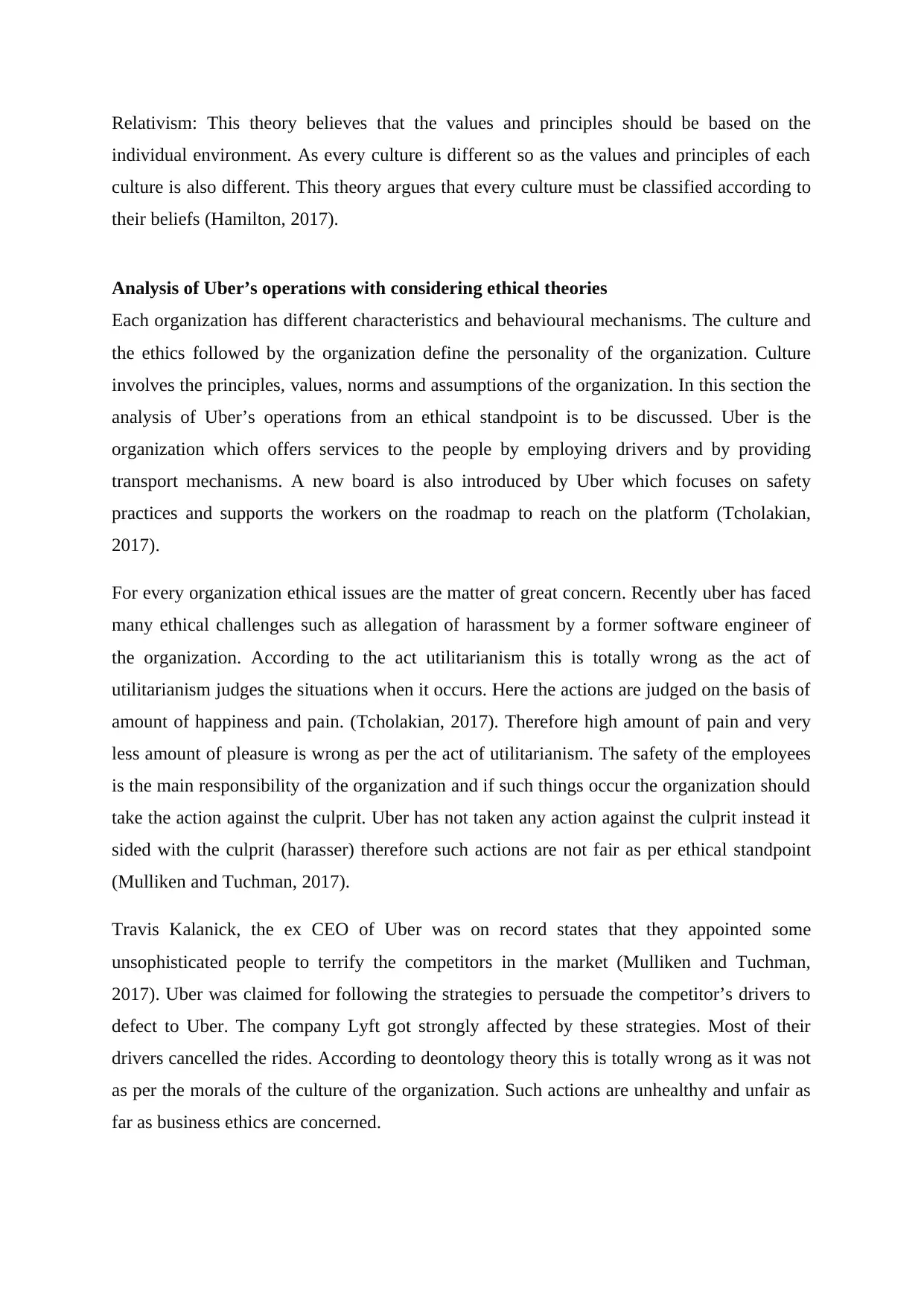
Relativism: This theory believes that the values and principles should be based on the
individual environment. As every culture is different so as the values and principles of each
culture is also different. This theory argues that every culture must be classified according to
their beliefs (Hamilton, 2017).
Analysis of Uber’s operations with considering ethical theories
Each organization has different characteristics and behavioural mechanisms. The culture and
the ethics followed by the organization define the personality of the organization. Culture
involves the principles, values, norms and assumptions of the organization. In this section the
analysis of Uber’s operations from an ethical standpoint is to be discussed. Uber is the
organization which offers services to the people by employing drivers and by providing
transport mechanisms. A new board is also introduced by Uber which focuses on safety
practices and supports the workers on the roadmap to reach on the platform (Tcholakian,
2017).
For every organization ethical issues are the matter of great concern. Recently uber has faced
many ethical challenges such as allegation of harassment by a former software engineer of
the organization. According to the act utilitarianism this is totally wrong as the act of
utilitarianism judges the situations when it occurs. Here the actions are judged on the basis of
amount of happiness and pain. (Tcholakian, 2017). Therefore high amount of pain and very
less amount of pleasure is wrong as per the act of utilitarianism. The safety of the employees
is the main responsibility of the organization and if such things occur the organization should
take the action against the culprit. Uber has not taken any action against the culprit instead it
sided with the culprit (harasser) therefore such actions are not fair as per ethical standpoint
(Mulliken and Tuchman, 2017).
Travis Kalanick, the ex CEO of Uber was on record states that they appointed some
unsophisticated people to terrify the competitors in the market (Mulliken and Tuchman,
2017). Uber was claimed for following the strategies to persuade the competitor’s drivers to
defect to Uber. The company Lyft got strongly affected by these strategies. Most of their
drivers cancelled the rides. According to deontology theory this is totally wrong as it was not
as per the morals of the culture of the organization. Such actions are unhealthy and unfair as
far as business ethics are concerned.
individual environment. As every culture is different so as the values and principles of each
culture is also different. This theory argues that every culture must be classified according to
their beliefs (Hamilton, 2017).
Analysis of Uber’s operations with considering ethical theories
Each organization has different characteristics and behavioural mechanisms. The culture and
the ethics followed by the organization define the personality of the organization. Culture
involves the principles, values, norms and assumptions of the organization. In this section the
analysis of Uber’s operations from an ethical standpoint is to be discussed. Uber is the
organization which offers services to the people by employing drivers and by providing
transport mechanisms. A new board is also introduced by Uber which focuses on safety
practices and supports the workers on the roadmap to reach on the platform (Tcholakian,
2017).
For every organization ethical issues are the matter of great concern. Recently uber has faced
many ethical challenges such as allegation of harassment by a former software engineer of
the organization. According to the act utilitarianism this is totally wrong as the act of
utilitarianism judges the situations when it occurs. Here the actions are judged on the basis of
amount of happiness and pain. (Tcholakian, 2017). Therefore high amount of pain and very
less amount of pleasure is wrong as per the act of utilitarianism. The safety of the employees
is the main responsibility of the organization and if such things occur the organization should
take the action against the culprit. Uber has not taken any action against the culprit instead it
sided with the culprit (harasser) therefore such actions are not fair as per ethical standpoint
(Mulliken and Tuchman, 2017).
Travis Kalanick, the ex CEO of Uber was on record states that they appointed some
unsophisticated people to terrify the competitors in the market (Mulliken and Tuchman,
2017). Uber was claimed for following the strategies to persuade the competitor’s drivers to
defect to Uber. The company Lyft got strongly affected by these strategies. Most of their
drivers cancelled the rides. According to deontology theory this is totally wrong as it was not
as per the morals of the culture of the organization. Such actions are unhealthy and unfair as
far as business ethics are concerned.
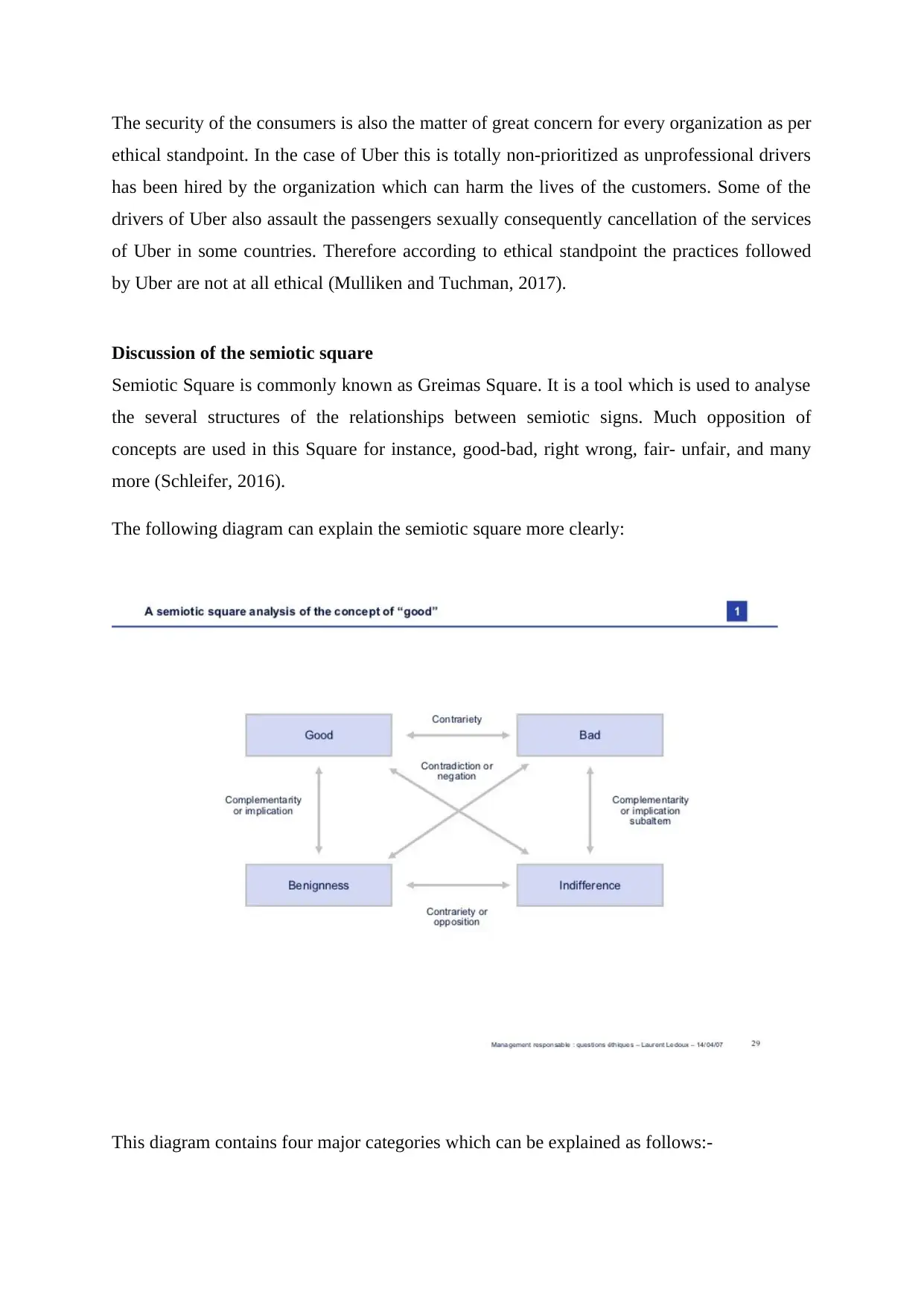
The security of the consumers is also the matter of great concern for every organization as per
ethical standpoint. In the case of Uber this is totally non-prioritized as unprofessional drivers
has been hired by the organization which can harm the lives of the customers. Some of the
drivers of Uber also assault the passengers sexually consequently cancellation of the services
of Uber in some countries. Therefore according to ethical standpoint the practices followed
by Uber are not at all ethical (Mulliken and Tuchman, 2017).
Discussion of the semiotic square
Semiotic Square is commonly known as Greimas Square. It is a tool which is used to analyse
the several structures of the relationships between semiotic signs. Much opposition of
concepts are used in this Square for instance, good-bad, right wrong, fair- unfair, and many
more (Schleifer, 2016).
The following diagram can explain the semiotic square more clearly:
This diagram contains four major categories which can be explained as follows:-
ethical standpoint. In the case of Uber this is totally non-prioritized as unprofessional drivers
has been hired by the organization which can harm the lives of the customers. Some of the
drivers of Uber also assault the passengers sexually consequently cancellation of the services
of Uber in some countries. Therefore according to ethical standpoint the practices followed
by Uber are not at all ethical (Mulliken and Tuchman, 2017).
Discussion of the semiotic square
Semiotic Square is commonly known as Greimas Square. It is a tool which is used to analyse
the several structures of the relationships between semiotic signs. Much opposition of
concepts are used in this Square for instance, good-bad, right wrong, fair- unfair, and many
more (Schleifer, 2016).
The following diagram can explain the semiotic square more clearly:
This diagram contains four major categories which can be explained as follows:-
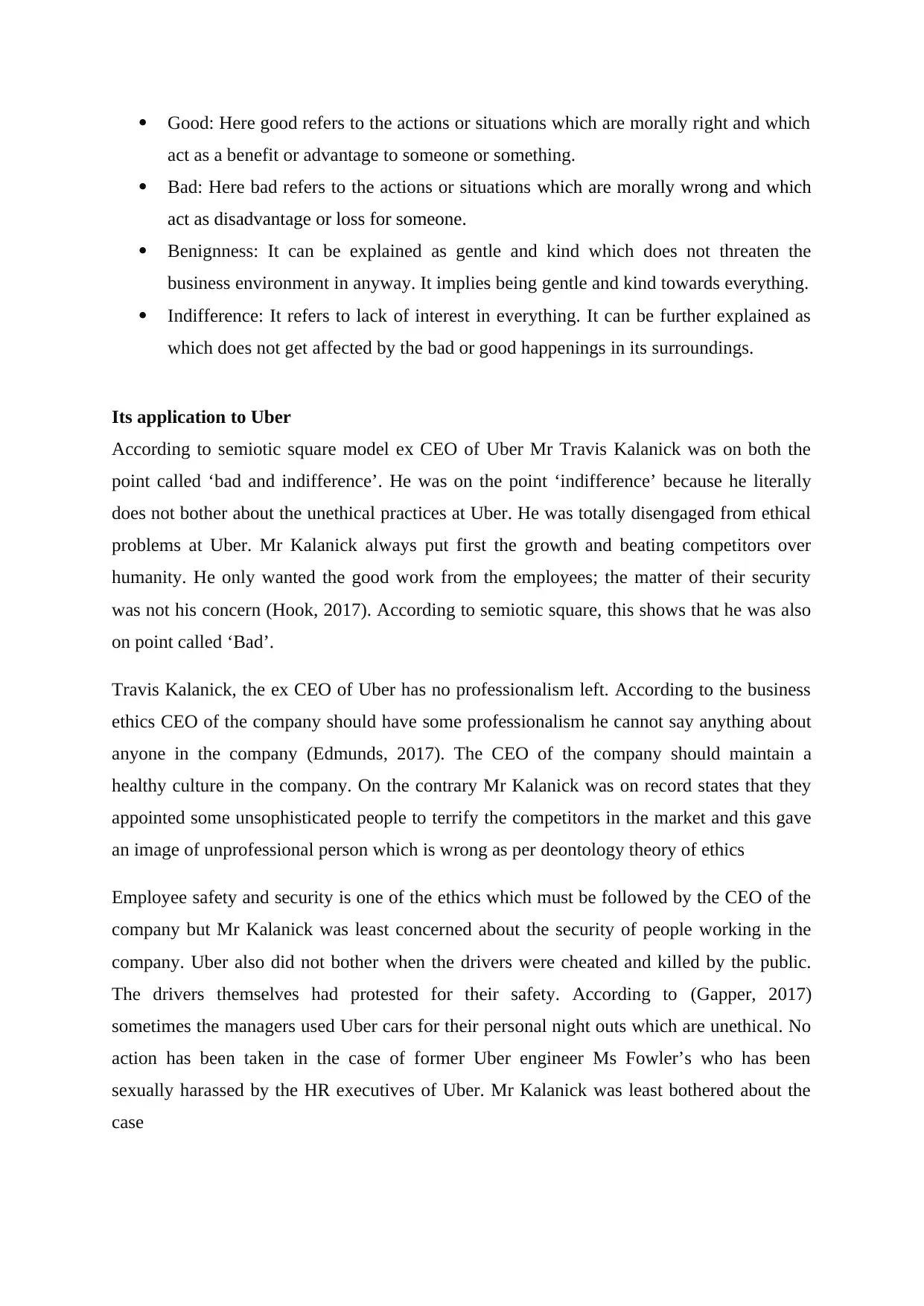
Good: Here good refers to the actions or situations which are morally right and which
act as a benefit or advantage to someone or something.
Bad: Here bad refers to the actions or situations which are morally wrong and which
act as disadvantage or loss for someone.
Benignness: It can be explained as gentle and kind which does not threaten the
business environment in anyway. It implies being gentle and kind towards everything.
Indifference: It refers to lack of interest in everything. It can be further explained as
which does not get affected by the bad or good happenings in its surroundings.
Its application to Uber
According to semiotic square model ex CEO of Uber Mr Travis Kalanick was on both the
point called ‘bad and indifference’. He was on the point ‘indifference’ because he literally
does not bother about the unethical practices at Uber. He was totally disengaged from ethical
problems at Uber. Mr Kalanick always put first the growth and beating competitors over
humanity. He only wanted the good work from the employees; the matter of their security
was not his concern (Hook, 2017). According to semiotic square, this shows that he was also
on point called ‘Bad’.
Travis Kalanick, the ex CEO of Uber has no professionalism left. According to the business
ethics CEO of the company should have some professionalism he cannot say anything about
anyone in the company (Edmunds, 2017). The CEO of the company should maintain a
healthy culture in the company. On the contrary Mr Kalanick was on record states that they
appointed some unsophisticated people to terrify the competitors in the market and this gave
an image of unprofessional person which is wrong as per deontology theory of ethics
Employee safety and security is one of the ethics which must be followed by the CEO of the
company but Mr Kalanick was least concerned about the security of people working in the
company. Uber also did not bother when the drivers were cheated and killed by the public.
The drivers themselves had protested for their safety. According to (Gapper, 2017)
sometimes the managers used Uber cars for their personal night outs which are unethical. No
action has been taken in the case of former Uber engineer Ms Fowler’s who has been
sexually harassed by the HR executives of Uber. Mr Kalanick was least bothered about the
case
act as a benefit or advantage to someone or something.
Bad: Here bad refers to the actions or situations which are morally wrong and which
act as disadvantage or loss for someone.
Benignness: It can be explained as gentle and kind which does not threaten the
business environment in anyway. It implies being gentle and kind towards everything.
Indifference: It refers to lack of interest in everything. It can be further explained as
which does not get affected by the bad or good happenings in its surroundings.
Its application to Uber
According to semiotic square model ex CEO of Uber Mr Travis Kalanick was on both the
point called ‘bad and indifference’. He was on the point ‘indifference’ because he literally
does not bother about the unethical practices at Uber. He was totally disengaged from ethical
problems at Uber. Mr Kalanick always put first the growth and beating competitors over
humanity. He only wanted the good work from the employees; the matter of their security
was not his concern (Hook, 2017). According to semiotic square, this shows that he was also
on point called ‘Bad’.
Travis Kalanick, the ex CEO of Uber has no professionalism left. According to the business
ethics CEO of the company should have some professionalism he cannot say anything about
anyone in the company (Edmunds, 2017). The CEO of the company should maintain a
healthy culture in the company. On the contrary Mr Kalanick was on record states that they
appointed some unsophisticated people to terrify the competitors in the market and this gave
an image of unprofessional person which is wrong as per deontology theory of ethics
Employee safety and security is one of the ethics which must be followed by the CEO of the
company but Mr Kalanick was least concerned about the security of people working in the
company. Uber also did not bother when the drivers were cheated and killed by the public.
The drivers themselves had protested for their safety. According to (Gapper, 2017)
sometimes the managers used Uber cars for their personal night outs which are unethical. No
action has been taken in the case of former Uber engineer Ms Fowler’s who has been
sexually harassed by the HR executives of Uber. Mr Kalanick was least bothered about the
case
Paraphrase This Document
Need a fresh take? Get an instant paraphrase of this document with our AI Paraphraser
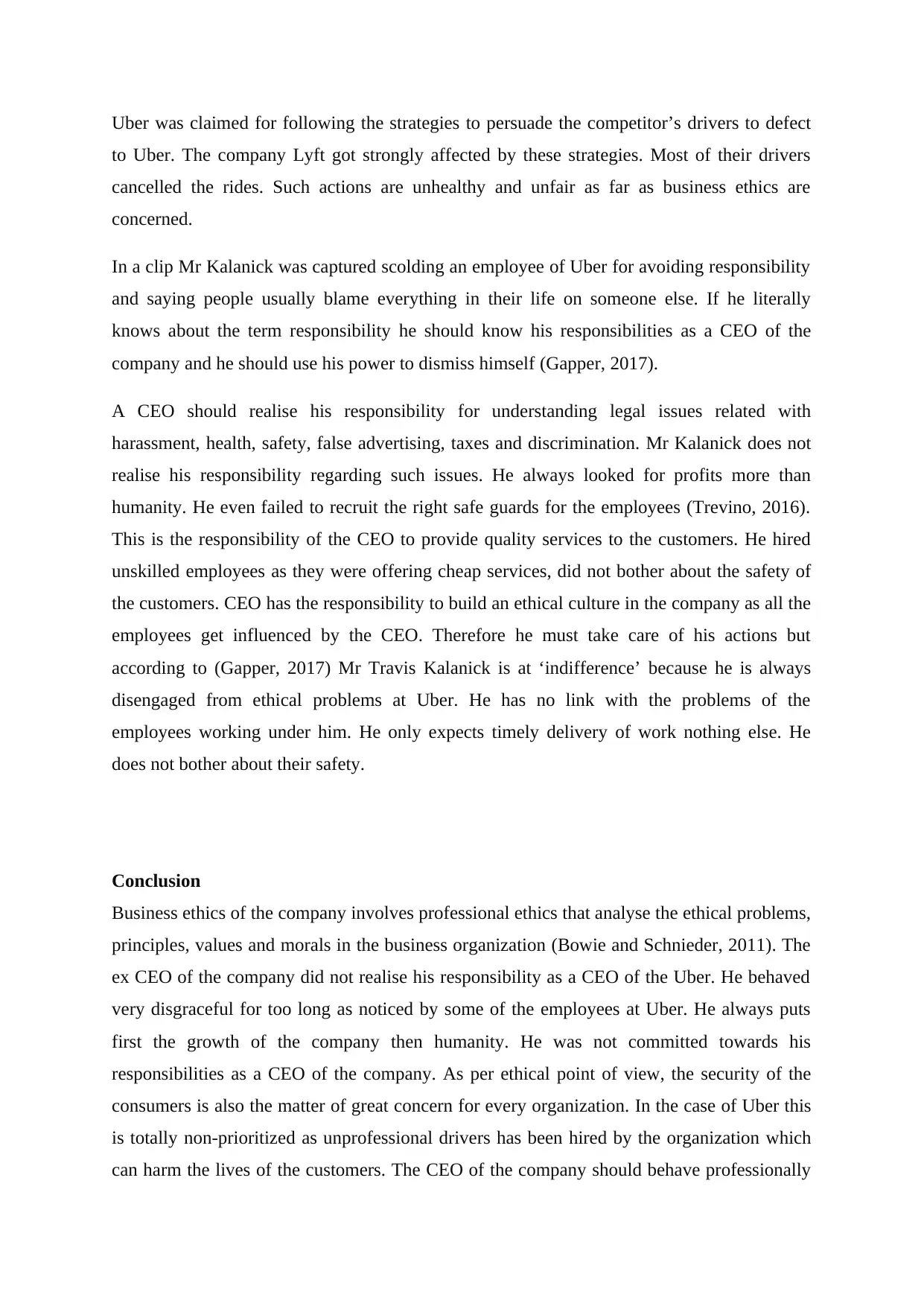
Uber was claimed for following the strategies to persuade the competitor’s drivers to defect
to Uber. The company Lyft got strongly affected by these strategies. Most of their drivers
cancelled the rides. Such actions are unhealthy and unfair as far as business ethics are
concerned.
In a clip Mr Kalanick was captured scolding an employee of Uber for avoiding responsibility
and saying people usually blame everything in their life on someone else. If he literally
knows about the term responsibility he should know his responsibilities as a CEO of the
company and he should use his power to dismiss himself (Gapper, 2017).
A CEO should realise his responsibility for understanding legal issues related with
harassment, health, safety, false advertising, taxes and discrimination. Mr Kalanick does not
realise his responsibility regarding such issues. He always looked for profits more than
humanity. He even failed to recruit the right safe guards for the employees (Trevino, 2016).
This is the responsibility of the CEO to provide quality services to the customers. He hired
unskilled employees as they were offering cheap services, did not bother about the safety of
the customers. CEO has the responsibility to build an ethical culture in the company as all the
employees get influenced by the CEO. Therefore he must take care of his actions but
according to (Gapper, 2017) Mr Travis Kalanick is at ‘indifference’ because he is always
disengaged from ethical problems at Uber. He has no link with the problems of the
employees working under him. He only expects timely delivery of work nothing else. He
does not bother about their safety.
Conclusion
Business ethics of the company involves professional ethics that analyse the ethical problems,
principles, values and morals in the business organization (Bowie and Schnieder, 2011). The
ex CEO of the company did not realise his responsibility as a CEO of the Uber. He behaved
very disgraceful for too long as noticed by some of the employees at Uber. He always puts
first the growth of the company then humanity. He was not committed towards his
responsibilities as a CEO of the company. As per ethical point of view, the security of the
consumers is also the matter of great concern for every organization. In the case of Uber this
is totally non-prioritized as unprofessional drivers has been hired by the organization which
can harm the lives of the customers. The CEO of the company should behave professionally
to Uber. The company Lyft got strongly affected by these strategies. Most of their drivers
cancelled the rides. Such actions are unhealthy and unfair as far as business ethics are
concerned.
In a clip Mr Kalanick was captured scolding an employee of Uber for avoiding responsibility
and saying people usually blame everything in their life on someone else. If he literally
knows about the term responsibility he should know his responsibilities as a CEO of the
company and he should use his power to dismiss himself (Gapper, 2017).
A CEO should realise his responsibility for understanding legal issues related with
harassment, health, safety, false advertising, taxes and discrimination. Mr Kalanick does not
realise his responsibility regarding such issues. He always looked for profits more than
humanity. He even failed to recruit the right safe guards for the employees (Trevino, 2016).
This is the responsibility of the CEO to provide quality services to the customers. He hired
unskilled employees as they were offering cheap services, did not bother about the safety of
the customers. CEO has the responsibility to build an ethical culture in the company as all the
employees get influenced by the CEO. Therefore he must take care of his actions but
according to (Gapper, 2017) Mr Travis Kalanick is at ‘indifference’ because he is always
disengaged from ethical problems at Uber. He has no link with the problems of the
employees working under him. He only expects timely delivery of work nothing else. He
does not bother about their safety.
Conclusion
Business ethics of the company involves professional ethics that analyse the ethical problems,
principles, values and morals in the business organization (Bowie and Schnieder, 2011). The
ex CEO of the company did not realise his responsibility as a CEO of the Uber. He behaved
very disgraceful for too long as noticed by some of the employees at Uber. He always puts
first the growth of the company then humanity. He was not committed towards his
responsibilities as a CEO of the company. As per ethical point of view, the security of the
consumers is also the matter of great concern for every organization. In the case of Uber this
is totally non-prioritized as unprofessional drivers has been hired by the organization which
can harm the lives of the customers. The CEO of the company should behave professionally
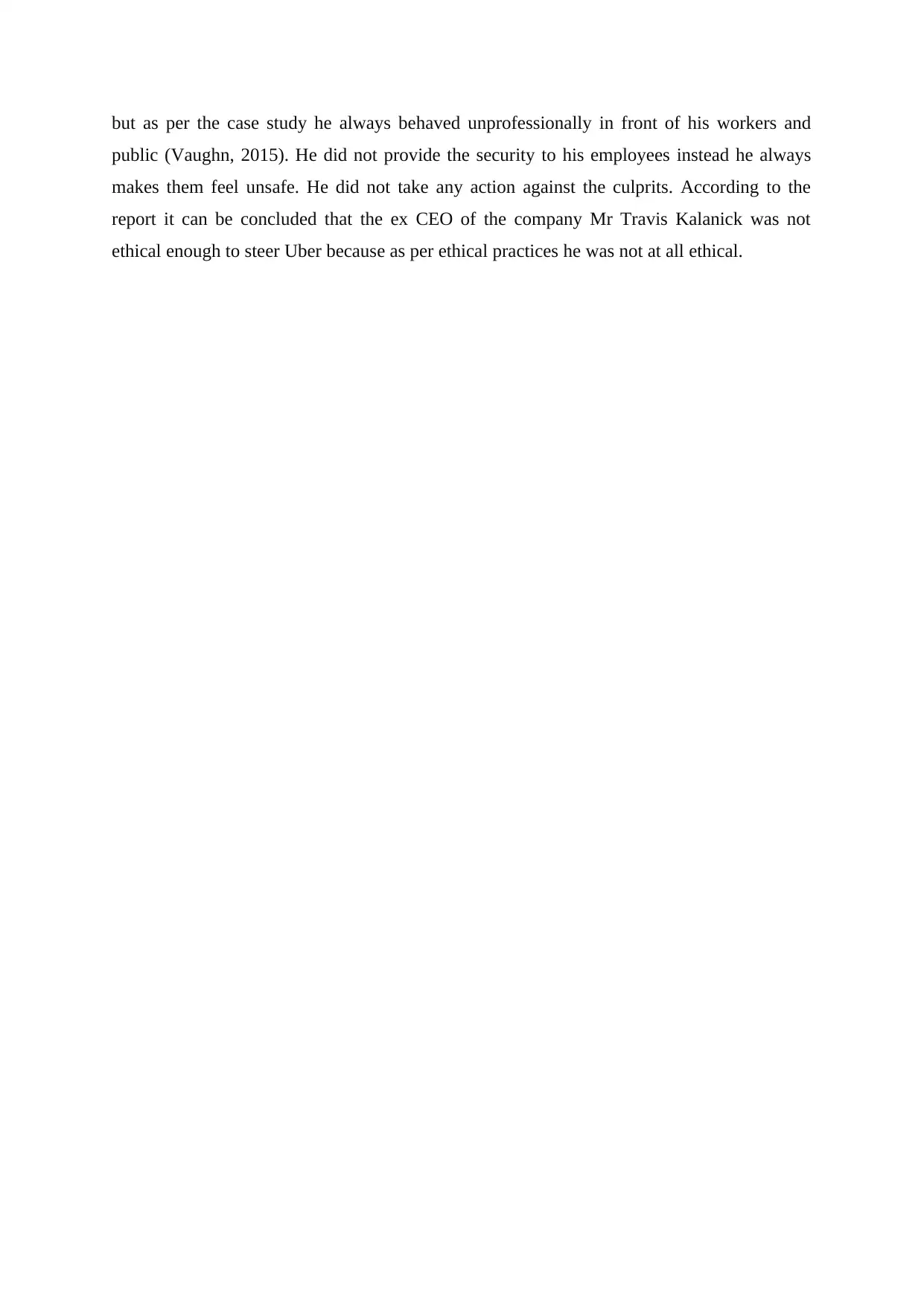
but as per the case study he always behaved unprofessionally in front of his workers and
public (Vaughn, 2015). He did not provide the security to his employees instead he always
makes them feel unsafe. He did not take any action against the culprits. According to the
report it can be concluded that the ex CEO of the company Mr Travis Kalanick was not
ethical enough to steer Uber because as per ethical practices he was not at all ethical.
public (Vaughn, 2015). He did not provide the security to his employees instead he always
makes them feel unsafe. He did not take any action against the culprits. According to the
report it can be concluded that the ex CEO of the company Mr Travis Kalanick was not
ethical enough to steer Uber because as per ethical practices he was not at all ethical.
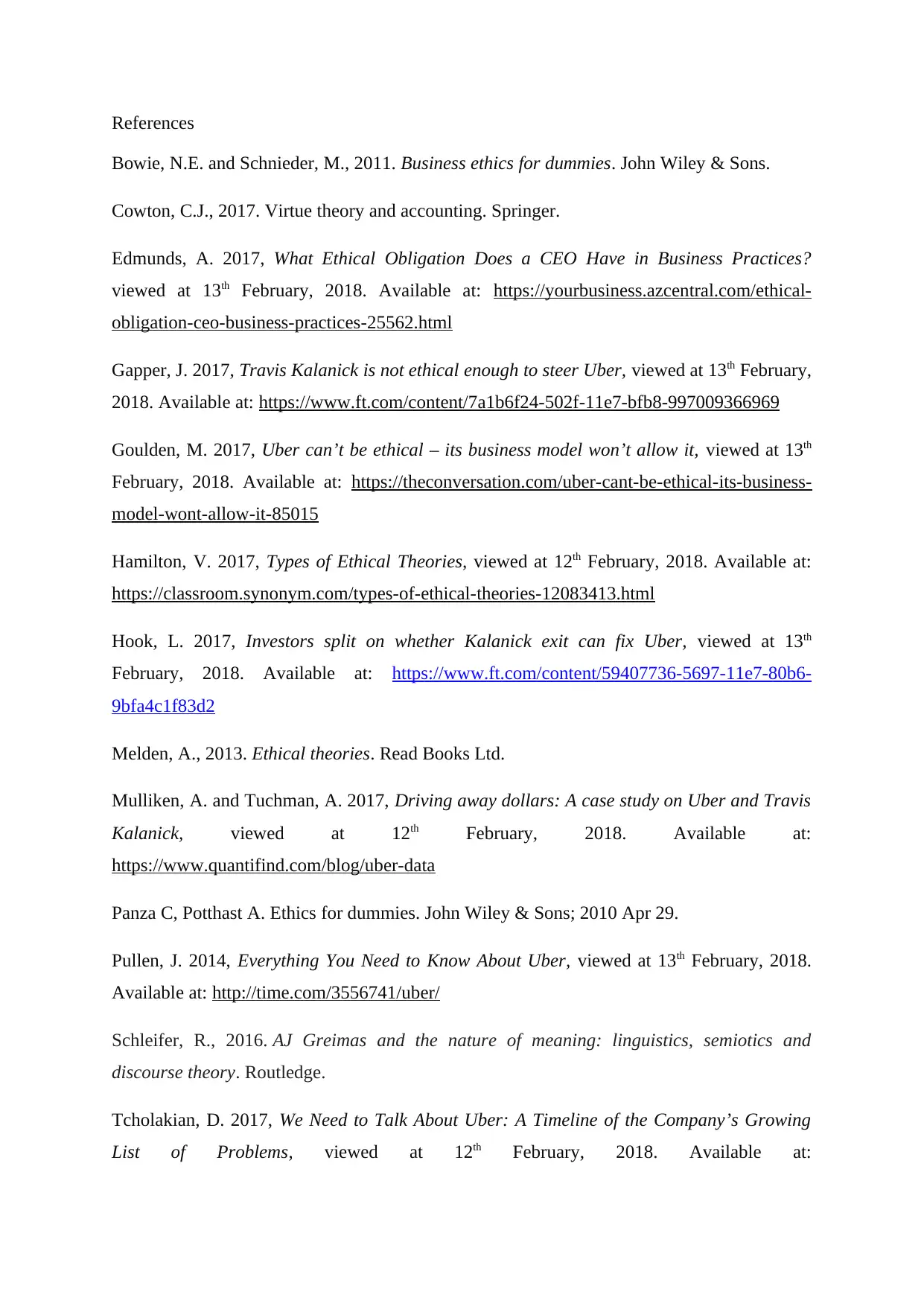
References
Bowie, N.E. and Schnieder, M., 2011. Business ethics for dummies. John Wiley & Sons.
Cowton, C.J., 2017. Virtue theory and accounting. Springer.
Edmunds, A. 2017, What Ethical Obligation Does a CEO Have in Business Practices?
viewed at 13th February, 2018. Available at: https://yourbusiness.azcentral.com/ethical-
obligation-ceo-business-practices-25562.html
Gapper, J. 2017, Travis Kalanick is not ethical enough to steer Uber, viewed at 13th February,
2018. Available at: https://www.ft.com/content/7a1b6f24-502f-11e7-bfb8-997009366969
Goulden, M. 2017, Uber can’t be ethical – its business model won’t allow it, viewed at 13th
February, 2018. Available at: https://theconversation.com/uber-cant-be-ethical-its-business-
model-wont-allow-it-85015
Hamilton, V. 2017, Types of Ethical Theories, viewed at 12th February, 2018. Available at:
https://classroom.synonym.com/types-of-ethical-theories-12083413.html
Hook, L. 2017, Investors split on whether Kalanick exit can fix Uber, viewed at 13th
February, 2018. Available at: https://www.ft.com/content/59407736-5697-11e7-80b6-
9bfa4c1f83d2
Melden, A., 2013. Ethical theories. Read Books Ltd.
Mulliken, A. and Tuchman, A. 2017, Driving away dollars: A case study on Uber and Travis
Kalanick, viewed at 12th February, 2018. Available at:
https://www.quantifind.com/blog/uber-data
Panza C, Potthast A. Ethics for dummies. John Wiley & Sons; 2010 Apr 29.
Pullen, J. 2014, Everything You Need to Know About Uber, viewed at 13th February, 2018.
Available at: http://time.com/3556741/uber/
Schleifer, R., 2016. AJ Greimas and the nature of meaning: linguistics, semiotics and
discourse theory. Routledge.
Tcholakian, D. 2017, We Need to Talk About Uber: A Timeline of the Company’s Growing
List of Problems, viewed at 12th February, 2018. Available at:
Bowie, N.E. and Schnieder, M., 2011. Business ethics for dummies. John Wiley & Sons.
Cowton, C.J., 2017. Virtue theory and accounting. Springer.
Edmunds, A. 2017, What Ethical Obligation Does a CEO Have in Business Practices?
viewed at 13th February, 2018. Available at: https://yourbusiness.azcentral.com/ethical-
obligation-ceo-business-practices-25562.html
Gapper, J. 2017, Travis Kalanick is not ethical enough to steer Uber, viewed at 13th February,
2018. Available at: https://www.ft.com/content/7a1b6f24-502f-11e7-bfb8-997009366969
Goulden, M. 2017, Uber can’t be ethical – its business model won’t allow it, viewed at 13th
February, 2018. Available at: https://theconversation.com/uber-cant-be-ethical-its-business-
model-wont-allow-it-85015
Hamilton, V. 2017, Types of Ethical Theories, viewed at 12th February, 2018. Available at:
https://classroom.synonym.com/types-of-ethical-theories-12083413.html
Hook, L. 2017, Investors split on whether Kalanick exit can fix Uber, viewed at 13th
February, 2018. Available at: https://www.ft.com/content/59407736-5697-11e7-80b6-
9bfa4c1f83d2
Melden, A., 2013. Ethical theories. Read Books Ltd.
Mulliken, A. and Tuchman, A. 2017, Driving away dollars: A case study on Uber and Travis
Kalanick, viewed at 12th February, 2018. Available at:
https://www.quantifind.com/blog/uber-data
Panza C, Potthast A. Ethics for dummies. John Wiley & Sons; 2010 Apr 29.
Pullen, J. 2014, Everything You Need to Know About Uber, viewed at 13th February, 2018.
Available at: http://time.com/3556741/uber/
Schleifer, R., 2016. AJ Greimas and the nature of meaning: linguistics, semiotics and
discourse theory. Routledge.
Tcholakian, D. 2017, We Need to Talk About Uber: A Timeline of the Company’s Growing
List of Problems, viewed at 12th February, 2018. Available at:
Secure Best Marks with AI Grader
Need help grading? Try our AI Grader for instant feedback on your assignments.
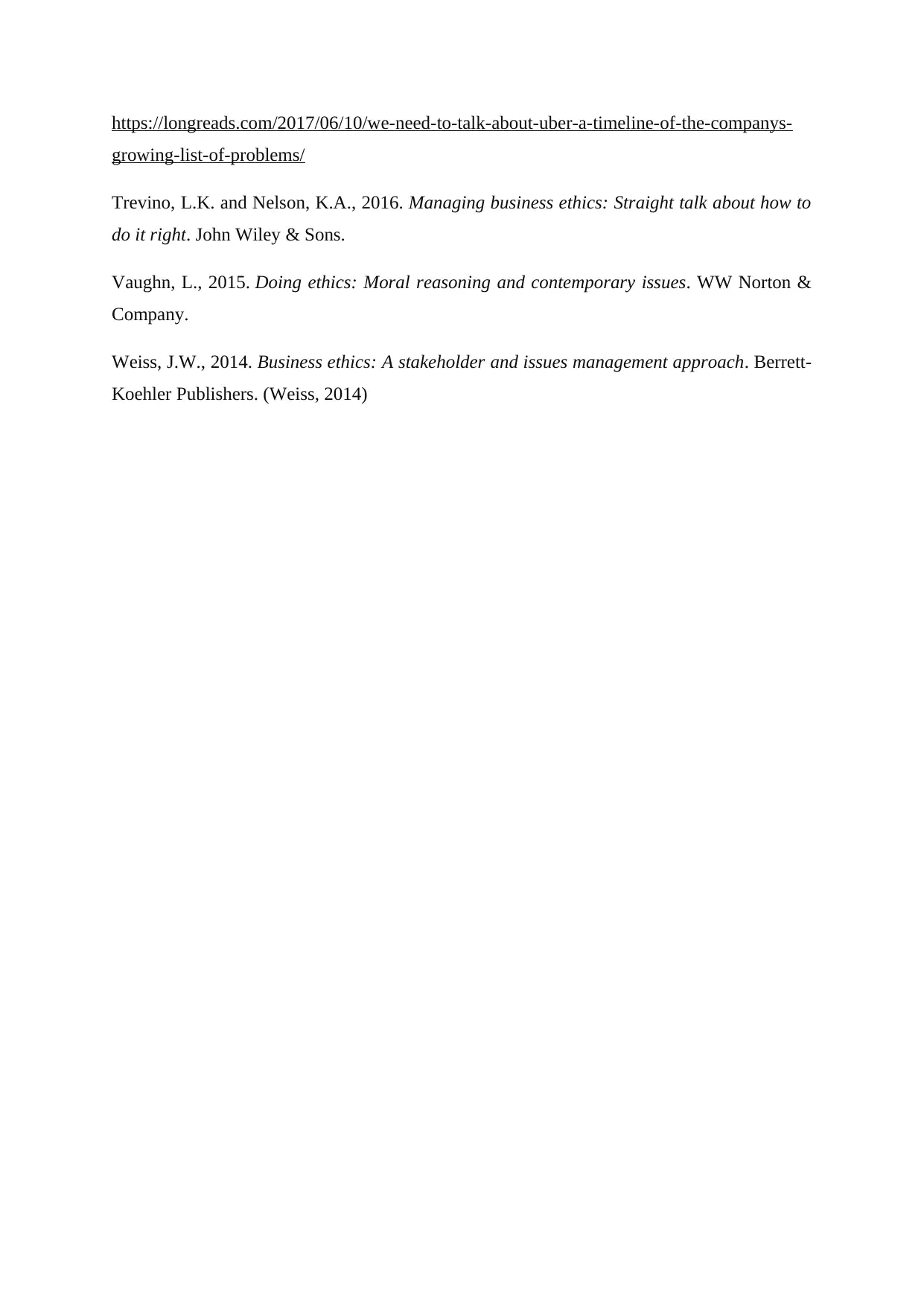
https://longreads.com/2017/06/10/we-need-to-talk-about-uber-a-timeline-of-the-companys-
growing-list-of-problems/
Trevino, L.K. and Nelson, K.A., 2016. Managing business ethics: Straight talk about how to
do it right. John Wiley & Sons.
Vaughn, L., 2015. Doing ethics: Moral reasoning and contemporary issues. WW Norton &
Company.
Weiss, J.W., 2014. Business ethics: A stakeholder and issues management approach. Berrett-
Koehler Publishers. (Weiss, 2014)
growing-list-of-problems/
Trevino, L.K. and Nelson, K.A., 2016. Managing business ethics: Straight talk about how to
do it right. John Wiley & Sons.
Vaughn, L., 2015. Doing ethics: Moral reasoning and contemporary issues. WW Norton &
Company.
Weiss, J.W., 2014. Business ethics: A stakeholder and issues management approach. Berrett-
Koehler Publishers. (Weiss, 2014)
1 out of 11
Related Documents
Your All-in-One AI-Powered Toolkit for Academic Success.
+13062052269
info@desklib.com
Available 24*7 on WhatsApp / Email
![[object Object]](/_next/static/media/star-bottom.7253800d.svg)
Unlock your academic potential
© 2024 | Zucol Services PVT LTD | All rights reserved.





